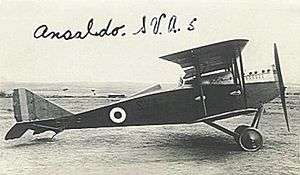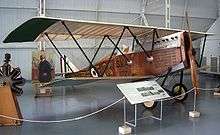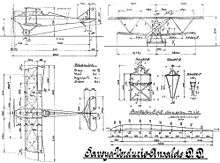Ansaldo SVA
The Ansaldo SVA (named for Savoia-Verduzio-Ansaldo) was a family of Italian reconnaissance biplane aircraft of World War I and the decade after. Originally conceived as a fighter, the SVA was found inadequate for that role. Nevertheless, its impressive speed, range and operational ceiling, with its top speed making it one of the fastest of all Allied combat aircraft in World War I, gave it the right properties to be an excellent reconnaissance aircraft and even light bomber. Production of the aircraft continued well after the war, the final examples were delivered during 1918.
| SVA | |
|---|---|
 | |
| SVA.5 Primo | |
| Role | Reconnaissance aircraft |
| Manufacturer | Gio. Ansaldo & C. |
| Designer | Umberto Savoia and Rodolfo Verduzio |
| First flight | 1917 |
| Number built | 1,245 |
The SVA was a conventionally laid-out unequal-span biplane - however, it was unusual in featuring Warren Truss-style struts joining its two wings, and therefore having no transverse (spanwise) bracing wires. The plywood-skinned fuselage had the typical Ansaldo triangular rear cross-section behind the cockpit, transitioning to a rectangular cross section going forwards through the rear cockpit area, with a full rectangular cross section forward of the cockpit.[1] Two minor variants were produced, one with reconnaissance cameras, the other without cameras but extra fuel tanks.
The Flight over Vienna propaganda flight, inspired by Italian nationalist and poet Gabriele d'Annunzio, consisting of an eleven plane flight of various models of Ansaldo SVA-series biplanes, was carried out on 9 August 1918 by the 87th Squadriglia La Serenissima from San Pelagio. At least two of the aircraft were twin-seater SVA 9 or 10s to accommodate d'Annunzio himself for the flight he inspired, while the remainder were SVA 5 single-seaters.
Development
Origins
According to aviation author Gianni Cattaneo, prior to 1916, the aviation companies of Italy were commonly producing aircraft which lacked any substantial originality or possessed noteworthy performance attributes, albeit with some exceptions, such as the Caproni Ca.4 heavy bomber.[2] While some figures within the industry were content to restrict their activity to forming arrangements to licence-produce foreign aircraft, particularly those of French origin, there were others who wanted to develop indigenous designs as well. What would become known as the SVA started life as the shared ideas of R. Verduzio and U. Savoia, two talented technical officers of Italy's Military Aviation Technical Directory.[2]
Even as a concept, it represented a considerable evolution in design practices, instead of using empirical observations, actual calculations of aerodynamic and structural were performed; Cattaneo claims that this was a first for the Italian industry.[2] A small design team, headed by aeronautical engineer Celestino Rosatelli, was assembled to work on turning the conceptual aircraft into reality. During its design phase, it was developed with the express goal of creating one of the fastest aircraft of its era, coupling this with a very high range capability and suitability for use as a fighter.[3] The finalised proposals for what was then designated as the SV, was laid before the directors of Italian manufacturer Gio. Ansaldo & C., hoping to obtain their authorisation to proceed.[2] However, the Military Aviation Technical Directory, having developed a considerable interest in the prospects of such an aircraft being produced, decided to assume control of the construction programme, effectively making it a government project. This came with some benefits, as the Italian government provided funding to cover the development along with the cooperation of various state agencies.[2]
Into flight
During November 1916, Ansaldo commenced construction upon a new aircraft factory, known at Catiere 1, at Borzoli, outside Genoa; further factories were either established or acquired during the following two years.[2] On 3 March 1917, the first SVA prototype performed its maiden flight from Grosseto, flown by Flight Sargeant M. Stoppani. Following this first flight, Stoppani was enthusiastic about his experience, favourably describing the prototype's handling characteristics and high speed.[2] It was subjected to an intense test programme, being flown at various locations inside and outside Italy, for the purpose of validating the design's performance and viability.[3] It was around this phase of work that it was decided to re-role the aircraft as a reconnaissance/fighter-bomber instead of a pure fighter, which represented a considerable shift in the specification; according to Cattaneo, this may have been done due to a perceived lack of maneuverability in comparison to some of its foreign competitors, such as the SPAD S.XIII and the Hanriot HD.1, and a lack of recognition amongst typical fighter pilots of its strengths, such as its speed and range.[4]
Testing of the prototype had revealed the aircraft to possess speeds 30 MPH in excess of any aircraft serving on the Italian Front at that time.[4] This outstanding speed, in combination with its range and load capabilities, made for an impressive fast reconnaissance aircraft, being able to dispense with escorts and break off from combat with opponents at will via its superior speed and rate of climb. However, it would not be confined solely to use within this role; during its service life, various sub-types and modifications were developed for a diverse range of purposes, which saw the aircraft being used to conduct numerous different duties.[4] Initially, the prototype was followed by a slightly modified aircraft, known as the SVA.4; it functioned as a stepping stone towards the definitive production variant, the SVA.5.[4]
Into production
In light of the prototype having demonstrated its capable performance characteristics, as well as the urgent demands imposed by the ongoing First World War, the SVA was rapidly ordered into production.[5] During late 1917, volume manufacture of the type commenced; by the end of the year, an initial batch of 65 aircraft had been produced. A number of the early aircraft produced at Cantierre 3, one of the production lines, were used to test various modifications, particularly alternative engine installations.[5] Reportedly, highly positive results were gathered on the Isotta Fraschini V.6, having cut the time to climb to 10,000 feet to only seven minutes, superior to widely used fighters such as the British Royal Aircraft Factory S.E.5 and the Germany Fokker D.VII. As such, during summer 1918, following confirmation of the performance figure via official testing conducted at Taliedo, outside Milan, it was decided to standardise the type upon the Isotta engine.[5]
As a consequence of the type's outstanding performance, the Italian Air Force's High Command urged for the SVA to be provided in vast quantities; thus, production output made rapid advances. While only 65 aircraft had been completed by the end of 1917, 1,183 SVAs were build during 1918; this made the type the second-most numerous aircraft to be built by the Italian aviation industry.[6] Around late 1917 and early 1918, licences to produce the SVA were issued to several other aircraft manufacturers with the intention of achieving a high rate of production. Some of these licensees decided to perform their own modifications to the aircraft, such as reducing the length and span of the wings.[5]
On the basis of the first few months of operation, two distinct sub-models of the SVA were developed, both of these being twin-seater aircraft.[6] The SVA.9, which was usually powered by the SPA 6A engine, was normally assigned for the training role. The SVA.10, powered by the Isotta engine, was intended for use as a light bomber and reconnaissance aircraft, armed with both a single fixed gun and a flexible Lewis gun, the latter of which being provisioned for use by the observer.[6]
Operational history
During early 1918, the SVA started to be issued to the second-line units, which were typically responsible for defensive missions such as the guarding of various Northern Italian cities and conducting reconnaissance operations along the Italian Front.[7] During February 1918, it formally commenced combined strategic reconnaissance and light bombing missions; for this purpose, special sections were organised and directly controlled by each headquarters of the Royal Italian Army. On 29 February, the first offensive operation was performed against railway infrastructure in Bolzano and Innsbruck.[8]
During a typical bombing mission, aircraft would have to fly between 200 and 350 miles, which often included two crossings of the Alps; upon approaching the target, the pilot would descend to 1,000 feet prior to any strafing or bombing runs.[8] Reconnaissance runs by the SVA were claimed to have played a major role during the Second Battle of the Piave River, providing Italian commanders with a near-continuous photographic representation of the turbulent battleground and helping them respond to rapid changes in the fighting. Imagery captured by one reconnaissance flight over the enemy harbour of Pula played a major role in a larger aerial bombing raid by 70 Italian aircraft several days later.[6] The type also performed propaganda missions during the battle, dropping leaflets over the enemy lines.[6]
Perhaps the most daring reconnaissance missions on the Italian Front were performed by 87 Sqadriglia; on 21 May 1918, a pair of SVAs departed Ghedi, near Brescia, and conducted a four-hour flight almost entirely inside hostile territory, covering 430 miles and capturing imagery over the Austrian towns of Bregenz, Lindau, and the German town of Friedrichshafen, by Lake Constance.[8] During this period, reconnaissance flights by the type were being performed of key railway depots on a near-daily basis, building up a detailed picture of the enemy's supply situation and the movement of reinforcements along the front. Cattaneo claims that the SVA had delivered remarkably effective performance in the reconnaissance role, especially for a single-engined, single-seat aircraft of the era.[9]
Perhaps the most audacious operation involving the SVA was conducted over the skies of Vienna, the capital of the Austria-Hungarian Empire, an act which effectively demonstrated the superiority of Italy over its opponent and its inability to prevent such flights from reaching into the heartland of the nation.[10] On 9 August 1918, a flight of seven SVAs of the 87th Squadriglia La Serenissima, based in San Pelagio, flew over Vienna and dropped thousands of propaganda leaflets, which had been specially prepared by the poet, soldier, and nationalist Gabriele D'Annunzio. Cattaneo observes that bombs could have been carried instead of leaflets, but that this had not been the purpose of the mission. D'Annunzio himself participated in the flight as an observer on an SVA.9.; 11 SVAs were involved in all.[11] Originally, the Vienna flight had been planned for 2 August 1918, but was delayed on account of unfavourable weather conditions on the day. The feat not only delivered a loud message of Italy's technological supremacy over Austria-Hungary, but forcefully delivered a warning of its rival's impending defeat to its own populace.[10]
According to Cattaneo, the SVA had been quickly regarded as perhaps the most precious platform for intelligence gathering in Italian service and was particularly welcomed by its pilots, having amply satisfied a long-standing requirement for a fast scout/light bomber capable of effective self-protection.[12] It has been claimed that reconnaissance performed by the type had been vital in the preparation of a major offensive, which included the decisive Italian victory at the Battle of Vittorio Veneto. During this final major clash, SVAs also intervened directly against hostile ground units, performing strafing and bombing runs against troop concentrations, communication centers, depots, railway infrastructure, and airfields.[13] This action demonstrated the operational maturity of the platform, which included the development of torpedo-armed and floatplane models for the Regia Marina. The Battle of Vittorio Veneto effectively ended the war on the Italian Front and forced the withdrawal of the Austria-Hungarian Empire from the conflict.[14]
Variants
- SVA.1 - single prototype
- SVA.2 - 65 production aircraft
- ISVA - (Idroplane - "seaplane") float-equipped version. 50 built for Italian navy
- SVA.3 - AER-built SVA.4
- SVA.3 Ridotto ("Reduced") - fast-climbing interceptor variant for anti-Zeppelin defence. Some fitted with additional oblique-firing machine gun
- SVA.4 - first major production version. Portside Vickers gun deleted to save weight for cameras.
- SVA.5 - definitive production version
- SVA.6 - prototype bomber version
- SVA.8 - single prototype; nature unclear
- SVA.9 - two-seat unarmed reconnaissance version with larger wings. Intended as pathfinder for SVA.5 formations, and as trainer
- SVA.10 - two-seat armed reconnaissance version with 250 hp Isotta Fraschini engine and fitted with single forward firing gun and a Lewis gun on a flexible mounting in the rear cockpit
Operators

- Army Aviation Service
- Brazilian Naval Aviation 12 brazilian pilots trained in these planes, but the war ended before they can participate it
- West-North Aviation Corps of Warlord Feng Yuxiang - 12 aircraft 1925
- Georgian Air Force - 10 aircraft 1920
- Lithuanian Air Force, 10 SVA-10, purchased in 1923
- Paraguayan Air Force
- Polish Air Force - 80 aircraft SVA .9
- Soviet Air Force
- American Expeditionary Force
- Yugoslav Royal Air Force - one aircraft
Specifications (SVA.5)

Data from The S.V.A. (Ansaldo) Scouts[15]
General characteristics
- Crew: 1
- Length: 8.1 m (26 ft 7 in)
- Wingspan: 9.1 m (29 ft 10 in)
- Height: 2.65 m (8 ft 8 in)
- Wing area: 24.2 m2 (260 sq ft)
- Empty weight: 680 kg (1,499 lb)
- Gross weight: 1,050 kg (2,315 lb)
- Powerplant: 1 × SPA 6A 6-cylinder water-cooled in-line piston engine, 150 kW (200 hp)
- Propellers: 2-bladed fixed-pitch propeller
Performance
- Maximum speed: 230 km/h (140 mph, 120 kn)
- Range: 690 km (430 mi, 370 nmi)
- Endurance: 3 hours
- Service ceiling: 6,000 m (20,000 ft)
- Rate of climb: 5 m/s (980 ft/min)
Armament
- Guns: 2 × synchronised .303 in (7.7 mm) Vickers machine guns
- Bombs: up to 90 kg (200 lb) of bombs
See also
References
Citations
- "Ansaldo SVA9". Air Progress. October 1971.
- Cattaneo 1966, p. 3.
- Cattaneo 1966, pp. 3–4.
- Cattaneo 1966, p. 4.
- Cattaneo 1966, p. 5.
- Cattaneo 1966, p. 7.
- Cattaneo 1966, pp. 5–6.
- Cattaneo 1966, p. 6.
- Cattaneo 1966, pp. 6–7.
- Cattaneo 1966, p. 8.
- Cattaneo 1966, pp. 8–9.
- Cattaneo 1966, pp. 6, 8.
- Cattaneo 1966, p. 9.
- Cattaneo 1966, pp. 6, 8–9.
- Cattaneo 1966, p. 10.
Bibliography
| Wikimedia Commons has media related to Ansaldo SVA. |
- Alegi, Gregory (1993). Ansaldo SVA 5 - Windsock Datafile 40. Hertfordshire, Great Britain: Albatros Productions Ltd. ISBN 0-9484-1450-2.
- Cattaneo, Gianni (1966). The S.V.A. (Ansaldo) Scouts - Profile Publications Number 61. Surrey, UK: Profile Publications Ltd.
- Taylor, Michael J. H. (1989). Jane's Encyclopedia of Aviation. London: Studio Editions. p. 62.
- World Aircraft Information Files. Brightstar Publishing: London. File 889 Sheet 62.
- Munson, Kenneth (1967). Aircraft of World War I. Ian Allan. ISBN 0-7110-0356-4.